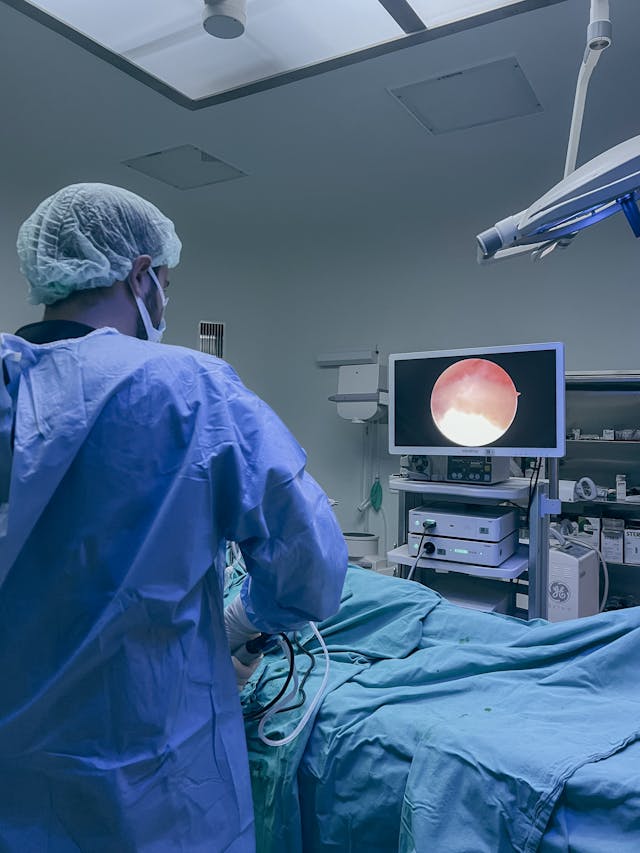CALL TODAY 646-933-3224 | EMAIL
Minimally Invasive Surgery: The Benefits of Laparoscopic and Robotic Procedures
 Surgical advancements have transformed the way medical professionals treat a wide range of conditions. Minimally invasive surgery (MIS) has become the preferred approach for many procedures, offering reduced pain, shorter recovery times, and fewer complications compared to traditional open surgery. Two of the most widely used minimally invasive techniques are laparoscopic surgery and robotic-assisted surgery, both of which allow surgeons to perform complex procedures with greater precision and control.
Surgical advancements have transformed the way medical professionals treat a wide range of conditions. Minimally invasive surgery (MIS) has become the preferred approach for many procedures, offering reduced pain, shorter recovery times, and fewer complications compared to traditional open surgery. Two of the most widely used minimally invasive techniques are laparoscopic surgery and robotic-assisted surgery, both of which allow surgeons to perform complex procedures with greater precision and control.
This guide explores the benefits of minimally invasive surgery, the differences between laparoscopic and robotic procedures, and the conditions that can be treated using these advanced surgical techniques.
What Is Minimally Invasive Surgery?
Minimally invasive surgery involves small incisions, specialized instruments, and high-tech imaging to perform surgical procedures with minimal trauma to the body. Instead of making a large incision, surgeons use tiny cameras and precision tools to operate with enhanced accuracy.
Key Advantages of Minimally Invasive Surgery
- Smaller incisions result in minimal scarring
- Reduced pain and discomfort post-surgery
- Shorter hospital stays (often same-day discharge)
- Faster recovery time, allowing patients to resume daily activities sooner
- Lower risk of infection and post-operative complications
- Less blood loss, reducing the need for transfusions
Minimally invasive techniques are particularly useful for general surgery, gastrointestinal procedures, and gynecological and urological surgeries.
Laparoscopic Surgery: A Minimally Invasive Standard
Laparoscopic surgery is one of the most commonly used minimally invasive techniques. It involves making small incisions, through which a laparoscope (a thin tube with a camera) and specialized instruments are inserted to perform the procedure.
How Laparoscopic Surgery Works
- A small incision is made near the surgical site
- A laparoscope (a small camera) is inserted to provide a clear view of the internal structures
- Surgeons use long, thin instruments to complete the surgery with precision
- The incisions are closed with minimal sutures
Benefits of Laparoscopic Surgery
- Minimally invasive approach reduces trauma to surrounding tissues
- Less post-operative pain compared to open surgery
- Faster healing and shorter recovery time
- Lower risk of complications, such as infections and blood clots
Common Procedures Performed Using Laparoscopic Surgery
Laparoscopic techniques are widely used in various surgical specialties, including:
- Gallbladder removal (cholecystectomy): A standard treatment for gallstones and gallbladder disease
- Hernia repair: Used to reinforce weakened abdominal walls
- Appendectomy: A minimally invasive option for treating appendicitis
- Colorectal surgery: Used for the treatment of diverticulitis, colorectal cancer, and inflammatory bowel disease
- Gastroesophageal reflux disease (GERD) surgery: A laparoscopic fundoplication can help manage severe acid reflux
Robotic-Assisted Surgery: Enhancing Precision and Control
 Robotic-assisted surgery is an advanced form of minimally invasive surgery that provides greater precision, flexibility, and control. The da Vinci Surgical System is the most commonly used robotic surgical platform, allowing surgeons to perform complex procedures with improved dexterity.
Robotic-assisted surgery is an advanced form of minimally invasive surgery that provides greater precision, flexibility, and control. The da Vinci Surgical System is the most commonly used robotic surgical platform, allowing surgeons to perform complex procedures with improved dexterity.
How Robotic-Assisted Surgery Works
Unlike traditional laparoscopy, robotic surgery involves:
- Surgeon-controlled robotic arms, which replicate natural hand movements with extreme precision
- High-definition 3D imaging, providing a magnified view of the surgical site
- Enhanced range of motion, allowing for delicate and intricate surgical maneuvers
Benefits of Robotic Surgery
Robotic-assisted procedures provide greater accuracy and better patient outcomes, especially for complex or delicate surgeries.
- Increased precision and control: The robotic system eliminates natural hand tremors, allowing for steady, precise movements
- Smaller incisions and minimal scarring
- Less blood loss and faster recovery times
- Improved visualization: Surgeons see a 3D, high-resolution image of the surgical area
- Better outcomes for delicate procedures, such as prostate surgery and colorectal resections
Common Procedures Performed Using Robotic Surgery
Robotic-assisted surgery is commonly used in:
- Hernia repairs: Provides greater precision for complex hernias
- Colorectal surgery: Used for colon cancer, diverticulitis, and inflammatory bowel disease
- Prostate surgery: Often the preferred method for prostatectomy (removal of the prostate gland)
- Gynecological procedures: Such as hysterectomy and myomectomy
- Thoracic surgery: Used for lung cancer and esophageal surgeries
Comparing Laparoscopic vs. Robotic Surgery
While both techniques offer minimally invasive benefits, there are key differences.
| Feature | Laparoscopic Surgery | Robotic-Assisted Surgery |
|---|---|---|
| Incision Size | Small (5-10mm) | Small (5-10mm) |
| Visualization | 2D HD Camera | 3D High-Definition Imaging |
| Surgeon Control | Hand-operated instruments | Robotic arms controlled by surgeon |
| Best For | Routine minimally invasive procedures | Complex or delicate surgeries requiring enhanced precision |
Recovery After Minimally Invasive Surgery
Minimally invasive procedures allow for quicker recovery times than traditional open surgery.
What to Expect Post-Surgery
- Hospital Stay: Most patients return home the same day or within 24 hours
- Pain Management: Over-the-counter or mild prescription pain medications
- Activity Restrictions: Avoid heavy lifting and strenuous exercise for 2-4 weeks
- Return to Normal Activities: Within 1-2 weeks for laparoscopic surgery and 2-3 weeks for robotic surgery
Conclusion: Choosing the Right Minimally Invasive Surgery
Minimally invasive surgical techniques, including laparoscopic and robotic-assisted surgery, provide safer, faster, and more effective options for a variety of medical conditions. Whether undergoing hernia repair, gallbladder surgery, or colorectal procedures, these advanced techniques allow for faster recovery, less pain, and improved surgical outcomes.
If you are considering surgery and want to explore minimally invasive options, our expert team at Lenox Hill Surgeons specializes in advanced laparoscopic and robotic-assisted procedures. Contact us today to discuss the best surgical approach for your condition and experience world-class surgical care.
Contact Information
LENOX HILL SURGEONS
155 East 76th Street
Suite 1C
New York, NY 10021
646-933-3224
lenoxhillsurgeons@gmail.com
Visit our website for more information: https://lenoxhillsurgeons.com/

